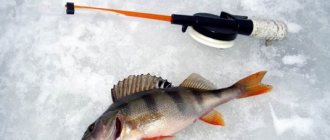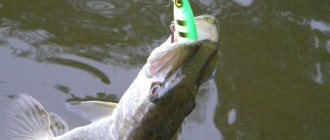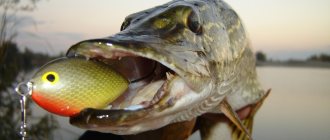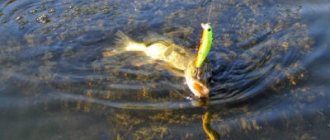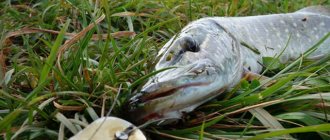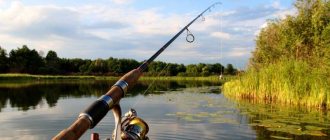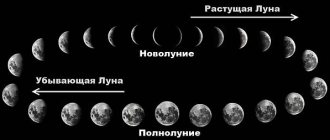Pike is an indigenous inhabitant of fresh water bodies, which is widespread in Europe, Asia, and North America. An adult reaches one and a half meters in length and weighs more than 5 kg. In some cases, fishermen mentioned giants exceeding 20 and 25 kg. The average size of the “toothy” fish, which readily falls for the bait, rarely reaches such values; usually the catch contains individuals from 1 to 1.5 kg. Sexual maturity of the predator occurs in the fourth year of life. The fry feeds on small worms, invertebrates, and other underwater creatures. As young pike grow older, they switch to large prey - small fish, tadpoles, frogs. Seasoned beauties do not disdain waterfowl rats, as well as birds.
What weather is best for pike fishing?
The predator, like peaceful fish, reacts to changes in external habitat conditions, which can favorably or negatively affect the mood of river inhabitants. Fish activity and bite depend on various factors:
- season;
- water and air temperatures;
- the presence of a current or its absence;
- weather conditions;
- atmospheric pressure;
- characteristics of a particular reservoir.
In addition, you can add the phase of the moon or the luck of the fisherman. It is impossible to predict a fine day so that the entire list of factors influencing the bite coincides. The main circumstances that determine the catch are the experience of the fisherman, the time of year, and weather conditions. By putting together such a puzzle, the chances of predicting favorable days for pike fishing increase significantly. Knowledge about the subtleties of the influence of weather conditions on fish at certain times of the year will help you return home with a good catch.
Weather indicators for pike fishing
Anyone who has been to a body of water several times notices that sometimes the weather is favorable and sometimes not quite favorable. It is the intricacies of weather conditions for catching trophy pike that we will understand further.
Pressure indicators
Choosing a promising place for pike fishing is not enough; to catch a trophy, you need to contact the heavenly office and find out what the pressure will be during the proposed fishing period. Catching a toothy predator will definitely be successful if the indicators are stable , but sudden jumps and changes will make their inhabitant sluggish and inactive.
The ideal option would be stable pressure for 3-4 days in a row; it is on these days that pike take almost any bait both in lakes and rivers.
Wind
In windy weather, pike can be caught in open water, but everything should be done in moderation. A good indicator of wind strength for each individual body of water that pike loves is large ripples in the water . In a small, closed lake, it is unlikely to achieve ripples at 6 m/s, but in a large one it is quite possible.
Does pike bite in calm weather? The answer to this question is clear, of course not. Such moments of weather are not suitable for her; potential victims can easily see her. But even in a strong wind, it may not respond to any of the proposed baits.
Illumination
In complete darkness it is difficult to catch, but it is not attracted to too bright daylight either. This is explained by the peculiarities of the behavior of the predator’s food base:
- in the dark, almost all the fry and peaceful fish sleep; they will come out to feed with the first rays of the sun;
- sunny weather forces residents of the reservoir to be more careful, since sufficient depths are visible.
What weather is best to catch pike then? A cloudy sky is ideal ; the toothy fish will bite especially well in the morning and evening dawn , as well as from 11 a.m. until lunchtime in the complete absence of sunlight.
Precipitation
Wind is important for pike, but precipitation is also not in last place. In the rain with a slight wind, the toothy one bites best in the fall, but even in the summer, such weather will be ideal for catching.
In what weather is it better to catch pike in the spring: in the rain there will definitely not be a bite, you need to go hunting for pike in sunny weather.
Moon phases
The Earth's satellite has a direct impact on fish inhabitants, especially on their bite. Pike is no exception; the phases of the moon do not affect it very much.
| satellite phase | bite quality |
| new moon | bites best, does not overload with baits at all |
| first quarter | the bite remains at the proper level, but the predator does not feed as actively |
| full moon | the bite is very weak, it is very difficult to interest the pike |
| last quarter | the predator begins to be interested in the offered baits again, but the activity is average |
Experienced fishermen say that not everyone will be able to catch a pike on a full moon, despite all the other excellent indicators. To do this you need to have a special fishing skill.
Having learned all the details, I would like to make the following conclusion: you need to go for pike on a new moon, at moderate air temperatures with stable pressure readings for several days and always with light rain. Then everyone who wants to will definitely be able to catch a pike without any problems.
Pike fishing in spring
As a rule, the predator’s active biting begins in early April and continues until spawning, after which the spotted beauty gets sick for a couple of weeks, refusing the baits offered to her. When going fishing, you need to take into account the characteristics of the reservoirs. Flowing rivers come to life after winter freeze-up much faster than lakes and ponds. A spring day is changeable - in the morning it can pamper you with bright sunshine, which is suddenly replaced by gusty winds and pouring rain. At this time of year, the weather affects the comfort of fishing more than the fish bite. Pike responds well on sunny and cloudy days.
To learn more:
Catching Black Sea shrimp - the best ways
Atmospheric pressure plays a big role. Its sharp change causes the fish to fall into a stupor and close its mouth in front of wobblers and spoons. Live bait rigs have an advantage in such conditions. Instead of chasing colored bait, it is easier for a predator to feast on a wounded fish. A good pressure for pike fishing is considered to be the transition period from a high to a low value. In this situation, oxygen dissolved in water is concentrated more in the lower layers, where pike wait for prey.
The influence of atmospheric pressure on biting
Atmospheric pressure can be safely called the main weather criterion, because the presence of precipitation, sudden changes in outside temperatures, wind strength and lighting intensity depend on its changes. Even on the eve of a pressure surge a couple of days before the onset of the phenomenon, fish can radically change their behavior, and this is not to mention the immediate time when this weather parameter begins to change. Next, we will consider the effect of changes in atmospheric pressure on pike biting and highlight the main characteristics of its behavior at such moments.
Pike biting at high atmospheric pressure
As a rule, with high pressure, the weather is clear and sunny, which is not particularly conducive to the stability of the bite. The illumination promotes better visibility in the water. Pike prey quickly notice the danger in the face of the predator and manage to hide even before the attack begins. Instinctively, the fish stops being active in terms of searching for food and becomes passive. At high pressure, only fairly fast and active pike baits can interest a predator, which must be taken into account when fishing in the conditions prevailing in such a scenario.
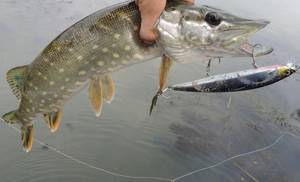
Pike biting during periods of low atmospheric pressure
Low atmospheric pressure is considered a favorable period for pike fishing. Cloudy weather with rain can significantly affect the improvement of the bite, and even during such periods large trophy fish come out in search of their prey more readily. A jump in pressure drop before a thunderstorm causes a zhora effect, which, if possible, must be taken advantage of even for a couple of hours of biting, sometimes bringing many times larger catches than a full day’s fishing.
At what pressure does a pike bite?
It is impossible to identify the optimal pressure for pike fishing in dimensional terms, because this value varies from the location of the fishing point to the height above sea level, and the location of the reservoir does not give reason to unify the parameter to a single value.
Important! It is generally accepted that stabilizing atmospheric pressure values, whether high or low, at the same level for three to four days provides the prerequisites for stabilizing the bite.
Sudden changes in levels can only cause a peak surge in fish activity for just a couple of hours, after which it will become passive until the parameter is calm and even.
How to determine atmospheric pressure while fishing
Of course, the best option would be to have a barometer with you so that you can track changes in atmospheric pressure in real time while fishing, and even better, if you have a mobile weather station, see forecasts for its parameters for the next couple of days. And today such devices are already quite accessible to fishermen, and the ability to access the Internet will always allow them to acquire the necessary information.
But a number of long-known methods for determining pressure based on natural phenomena will not hurt the fisherman. In particular, sunny, clear weather indicates a high level of pressure. Finding dense clouds and cloudiness – on the contrary, its lower values. Having paid attention to the oiliness of the water surface, which is justified by the increase in its density, and the presence of foam near the shore, we can safely talk about a drop in pressure and the time when catching pike on a spinning rod, especially in the fall, becomes the most suitable period.
Summer fishing
Unlike the spring season, when the “toothy” biting peaks in activity, summer is marked by short outings of the small predator. On clear, hot days, as a rule, mostly small fish up to a kilogram are caught, with rare catches of heavier trophies. The bite is observed early in the morning, until the sun begins to get hot and the wind rises. The hot part of the day rarely produces results, but activity resumes before sunset and lasts no more than an hour.
If you manage to predict a cloudy day, the predator will bite successfully throughout the entire fishing trip. The best weather for pike fishing in summer is cloudy, with a slight breeze, and stable atmospheric pressure. Often the largest specimens were obtained in the rain. The natural exchange of water saturates the water area with oxygen and activates its inhabitants.
It is worth noting that a strong gusty wind does not promise a rich catch, because it is impossible to make accurate casting and retrieving in such conditions. A waterproof raincoat, a spinning rod with a high test limit and heavy baits will help you cope with natural phenomena.
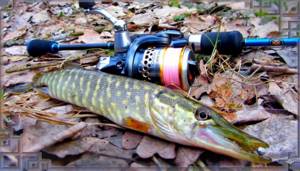
The best weather for catching pike by season
It is impossible to say for sure what weather is best for pike fishing; each season makes its own adjustments to these indicators. In spring, the best weather for pike fishing is always sunny, but in summer and autumn, the daylight will only interfere and scare away the predator. Next, we will consider all the subtleties of weather conditions for an excellent bite for each season separately.
Autumn
In the autumn, it is best to go for trophy pike in the rain, which has not stopped for several days. The temperature regime is moderate, at 16-20 degrees Celsius during the day, the water in any body of water will warm up enough, but not very much, and this is exactly what the predator needs.
In sunny weather it will be more difficult to catch pike. This is due to the fact that the water has already stopped blooming; it becomes transparent, and a cautious predator will be able to see the danger from afar.
During this period, baits are not placed at the very bottom. In medium thicknesses. The best time will be lunch and afternoon.
From mid-October, the pike begins to get hungry; it will bite on everything without exception and with virtually no regard for weather conditions. The only important indicator will be the phase of the moon; it is better not to go to a body of water during a full moon.

Winter
In winter, pike bite better on first ice, there is still enough oxygen in the reservoir, it continues to actively feed, so it is easy to attract it with almost any bait.
The wilderness with severe frosts is not the best time for catching any type of fish. Few people go fishing for pike during this period, and in general there are few fishermen on the ice. But even during this period you can get trophies of the predator; to do this, go for the capture before any warming and in sunny weather.
The last days of winter with a drop will help even a beginner to catch a pike without any problems. Fishing will be especially good on sunny days; hungry pike will attack almost any bait.
Spring
Are there any peculiarities of catching once after crossing the ice and in what spring weather does pike bite better?
Warming will benefit everyone, the long-awaited sun will make the fish become active. During this period, the pike begins its pre-spawning glutton, the predator rushes at almost everything. But sudden changes in temperature and pressure will play a cruel joke; it will stop responding to even the most catchy bait.
This is followed by a spawning ban ; fishing in some water bodies is completely prohibited, while significant restrictions come into force in others. After spawning, in any weather and phase of the moon, the pike will not be caught at all for about 10-14 days; it is during this period that it will be “sick.” But then comes the post-spawning frenzy, when the predator will attack almost everything; this is considered the best time for catching pike in the spring.
Summer
Pike does not like the summer heat very much; on hot days it often hides at depths of 5 m . but even there it will not be easy to interest her. At high air and water temperatures, the predator becomes lethargic and almost completely stops feeding.
Before a thunderstorm approaches, when the rumble of thunder is heard in the distance, but there is no rain yet, this is the perfect time to offer the toothy resident of the reservoir something appetizing. She will react instantly, and most often it is trophy specimens that are on the hook.
In cloudy weather with moderate temperatures, pike will respond to almost all baits used to catch it. And if such weather lasts for several days, and in the mornings and evenings fog spreads over the reservoir, then everyone will be able to catch a decent-sized predator with minimal skills.
Hunting for “toothy” in the fall
With the onset of cold weather and the season of yellowing leaves, the predator begins to gain weight for the winter. Unlike summer, autumn is rich in trophy specimens. In addition to the size of the prey, weather conditions for pike fishing change. Now the fish can actively feed during daylight hours, regardless of the weather. Nice, quiet days bring more bites than cloudy days with drizzling rain. You also can’t count on a bite in the early morning, because the predator’s breakfast begins when the sun appears and the temperature rises by several degrees.
Closer to winter, with the first frosts, you should look for fish in deep places. The lower the water temperature, the more passive the predator. In November, it is not easy to arouse the appetite of pike; for this, you should take into account not only fishing methods, but also precipitation, ice crust off the coast, and pressure.
Pike in September
Pike fishing in September depends on the vagaries of the weather of that month. The range of night and day temperatures can be more than 15 degrees. Sunny days can quickly give way to cloudy and rainy days, and sudden changes in weather conditions can occur within 24 hours. In such conditions, pike fishing becomes more difficult. But the voracious predator constantly needs food, and if you know the peculiarities of its behavior at the beginning of autumn, you can count on productive fishing.
On sunny days, pike ambush in shaded coastal areas in September. Tree crowns hanging over the water, abundant coastal vegetation, the presence of trees fallen into the water, snags and scurrying schools of small fish are excellent signs of the presence of pike. In bays, small rivers and small lakes, a hidden predator can be seen from the shore without special equipment. She also gives herself away with sharp lunges for her prey.
In the first half of September, pike can be successfully caught with all available gear, using artificial baits and live bait. On sunny, warm days, pike rarely leave their shelters. Moreover, potential prey itself often swims up to the predator “under the nose.” In such conditions, fishing of the coastal strip is carried out. When fishing with a spinning rod, it is more convenient to fish from a boat, wade or from bridges. Live bait gear is also cast in the coastal zone.
As the temperature steadily decreases, and when the thermometer does not reach 20°, pike more often leaves the coastal zone, and can be found in any part of the reservoir in which small fish are concentrated.
It should be taken into account that crucian carp, perch or roach weighing about 100 g are potential prey for predators.
In mid-autumn, on large lakes, the probability of catching pike increases when fishing by trolling and with mugs.
Freeze-up period
Winter is a new page for predator hunting lovers. The peculiarities of ice fishing force you to monitor weather reports, not only because it affects the activity of the fish, but for your own comfort on the ice. A frozen person does not enjoy the process of sparkling, but dreams of being at home, warm. The best time to hunt for pike is during the thaw. A little snowfall will also have a positive effect on the bite. Fishing with girders is possible even at low temperatures reaching -15-20°C. It is uncomfortable to operate a spinner in cold weather. The girders, which the fisherman watches from a warm tent, help out.
To learn more:
Features of catching pike on girders
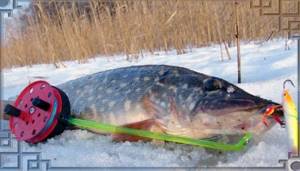
??ideal day for pike fishing in spring
General position:
The weather shouldn't be too hot. If April was warm like summer, then the pike had already satisfied its hunger, moved from shallow spawning grounds and dispersed throughout the lake. Then it's hard to find. The ideal weather is normal April weather, rather cold and rainy, which smoothly transitions into the sunny season.
Daytime weather:
Weather reports predict "high pressure impacts." Thick fog hangs over the water. Once it has dissipated, look into the blue sky. The sun is shining in full force. Small fish approach the shore, bleak and roach splash on the surface. On days like these, pike bite like crazy. I remember a 6-kilogram pike that had at least three roach in its stomach, about 200 g each, when it also took my dead fish.
About
What is the best pressure for pike fishing?
Based on experience, it can be argued that there are no specific digital indicators. However, pike react in their own way to changes in these numbers. If the pressure has not changed for several days, the fish feels good and you can count on a bite. However, there are periods when the indicator changes daily, then there is no question of stability. It has been noticed that the predator is more active at the same low pressure. It is easy to determine; for this purpose there is a specialized device - a barometer. It is small in size and does not take up extra space in the house.
Precipitation when fishing for pike
Light drizzle with moderate winds is the ideal precipitation as part of the “pike weather” package. When the tedious rain, without intensifying and calming down, slowly pours on you from morning to evening - it is at such a time that pike activity is greatest in a reservoir with such weather.
It is easier to deceive a large pike with a spoon when there are ripples on the water from light rain
A good raincoat or membrane suit with decent performance will allow you to not only withstand
such weather, but also enjoy frequent bites from active pike.
What kind of wind does pike bite in?
Like pressure, this indicator plays a role, but not the key one. The direction of the wind does not affect the activity of the fish as much as its strength. Based on the situation on the reservoir, you should choose a fishing spot in such a way that the wind blows from the back or from the side. If fishing is carried out from a boat, in case of strong gusts it makes sense to leave the clear water area, giving preference to shallow bays, covered on all sides by dense thickets of reeds. The southern wind direction is much more pleasant than the northern one, since the air flow does not penetrate clothes so much.
Moderate gusts of wind, up to 5 m/s, play into the hands of the fisherman, because due to the disturbance of the water surface, the water area is saturated with oxygen, which forces river inhabitants to behave actively. In bad weather, it is better to arm yourself with a heavier rod and equipment, since it will not be possible to correctly retrieve with light weight. Lures that are preferred in bad weather:
- oscillating spoons;
- silicone on heavy jig;
- large wobblers, jerks;
- rotating spoons with front loading.
Poppers should be immediately taken out of the fishing box, since fishing on waves is impossible with them. You should also leave a light rod at home with baits up to 3 inches
Rain
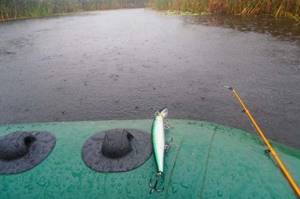
In rainy weather, pike bite more actively. She sees less of what is happening on the surface of the water; the clarity is blurred by raindrops. Precipitation is the result of a decrease in atmospheric pressure, and in such conditions the toothy fish bites better. If it drizzles for three days, you can safely go fishing. The probability of a good bite will be high.
In autumn, it happens that pike become more active even during heavy rain. In this case, the wind can be up to 5 m/s. From the point of view of the fisherman, the conditions are not very comfortable, but for the fish - on the contrary. The water is well enriched with oxygen, its transparency is reduced due to mud flowing from the banks.
The predator loses its vigilance and is not always able to distinguish a wobbler and spinner from a fry in this turbidity. On the eve of winter, her appetite is excellent (that same autumn glutton), so trophy specimens in such nasty weather are not at all uncommon.
